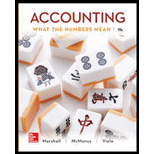
(A)
Concept Introduction:
Shares issued refer to the number of shares that are allocated to the stockholders by way of sale.
It is calculated as:
Number of shares issued * Par value of each share.
Shares Outstanding is the number of shares issued but which are still held with the stockholder and are not reacquired. It is calculated as:
Shares Outstanding = Number of Shares issued - Number of Treasury shares.
The par value of each share of
(B)
Concept Introduction:
Shares issued refers to the number of shares that are allocated to the stockholders by way of sale.
It is calculated as:
Number of shares issued * Par value of each share.
Shares Outstanding is the number of shares issued but which are still held with the stockholder and are not reacquired. It is calculated as:
Shares Outstanding = Number of Shares issued - Number of Treasury shares.
Treasury stock - When the firm reacquires its own shares and does not retire them, it is known as treasury stock.
The amount of common stock as at June 30, 2016
(C)
Concept Introduction:
Shares issued refers to the number of shares that are allocated to the stockholders by way of sale.
It is calculated as:
Number of shares issued * Par value of each share.
Shares Outstanding is the number of shares issued but which are still held with the stockholder and are not reacquired. It is calculated as:
Shares Outstanding = Number of Shares issued - Number of Treasury shares.
Treasury stock - When the firm reacquires its own shares and does not retire them, it is known as treasury stock.
The average issue price of common stock in the balance sheet on June 3, 2016.
(D)
Concept Introduction:
Shares issued refers to the number of shares that are allocated to the stockholders by way of sale.
It is calculated as:
Number of shares issued * Par value of each share.
Shares Outstanding is the number of shares issued but which are still held with the stockholder and are not reacquired. It is calculated as:
Shares Outstanding = Number of Shares issued - Number of Treasury shares.
Treasury stock - When the firm reacquires its own shares and does not retire them, it is known as treasury stock.
The number of shares of treasury stock held by DeZurik Corp. at June 30, 2016.
(E)
Concept Introduction:
Shares issued refers to the number of shares that are allocated to the stockholders by way of sale.
It is calculated as:
Number of shares issued * Par value of each share.
Shares Outstanding is the number of shares issued but which are still held with the stockholder and are not reacquired. It is calculated as:
Shares Outstanding = Number of Shares issued - Number of Treasury shares.
Treasury stock - When the firm reacquires its own shares and does not retire them, it is known as treasury stock.
The total amount of treasury stock held by the form in the balance sheet on June 30, 2016.
(F)
Concept Introduction:
Shares issued refers to the number of shares that are allocated to the stockholders by way of sale.
It is calculated as:
Number of shares issued * Par value of each share.
Shares Outstanding is the number of shares issued but which are still held with the stockholder and are not reacquired. It is calculated as:
Shares Outstanding = Number of Shares issued - Number of Treasury shares.
Treasury stock - When the firm reacquires its own shares and does not retire them, it is known as treasury stock.
The
(G)
Concept Introduction:
Shares issued refers to the number of shares that are allocated to the stockholders by way of sale.
It is calculated as:
Number of shares issued * Par value of each share.
Shares Outstanding is the number of shares issued but which are still held with the stockholder and are not reacquired. It is calculated as:
Shares Outstanding = Number of Shares issued - Number of Treasury shares.
Treasury stock - When the firm reacquires its own shares and does not retire them, it is known as treasury stock.
The retained earnings balance at June 30, 2016 with retained earnings balance at July 1, 2015 using statement of retained earnings or T-account analysis.
Want to see the full answer?
Check out a sample textbook solution
Chapter 8 Solutions
Accounting: What the Numbers Mean
- Can you solve this financial accounting problem using appropriate financial principles?arrow_forwardCan you solve this general accounting question with accurate accounting calculations?arrow_forwardPlease explain the solution to this general accounting problem with accurate explanations.arrow_forward
- I am looking for help with this general accounting question using proper accounting standards.arrow_forwardEddie Woodworks manufactures custom shelving. During the most productive month of the year, 4,200 units were manufactured at a total cost of $73,500. In the month of lowest production, the company made 1,600units at a cost of $49,800. Using the high-low method of cost estimation, total fixed costs are__.arrow_forwardPlease provide the correct answer to this financial accounting problem using valid calculations.arrow_forward

 AccountingAccountingISBN:9781337272094Author:WARREN, Carl S., Reeve, James M., Duchac, Jonathan E.Publisher:Cengage Learning,
AccountingAccountingISBN:9781337272094Author:WARREN, Carl S., Reeve, James M., Duchac, Jonathan E.Publisher:Cengage Learning, Accounting Information SystemsAccountingISBN:9781337619202Author:Hall, James A.Publisher:Cengage Learning,
Accounting Information SystemsAccountingISBN:9781337619202Author:Hall, James A.Publisher:Cengage Learning, Horngren's Cost Accounting: A Managerial Emphasis...AccountingISBN:9780134475585Author:Srikant M. Datar, Madhav V. RajanPublisher:PEARSON
Horngren's Cost Accounting: A Managerial Emphasis...AccountingISBN:9780134475585Author:Srikant M. Datar, Madhav V. RajanPublisher:PEARSON Intermediate AccountingAccountingISBN:9781259722660Author:J. David Spiceland, Mark W. Nelson, Wayne M ThomasPublisher:McGraw-Hill Education
Intermediate AccountingAccountingISBN:9781259722660Author:J. David Spiceland, Mark W. Nelson, Wayne M ThomasPublisher:McGraw-Hill Education Financial and Managerial AccountingAccountingISBN:9781259726705Author:John J Wild, Ken W. Shaw, Barbara Chiappetta Fundamental Accounting PrinciplesPublisher:McGraw-Hill Education
Financial and Managerial AccountingAccountingISBN:9781259726705Author:John J Wild, Ken W. Shaw, Barbara Chiappetta Fundamental Accounting PrinciplesPublisher:McGraw-Hill Education





